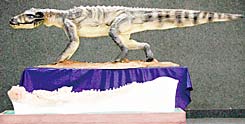Scientists in Brazil recently unveiled 11 fossilized skeletons of prehistoric crocodiles that were recently discovered, saying their findings indicate that a land bridge once linked South America and India-Pakistan.

A model of a crocodile of the species Baurusuchus salgadoensis and part of a fossil are on display at the University of Rio de Janeiro.
Direct link to this page: https://www.hayadan.org.il/taninim010706.html
Scientists in Brazil recently unveiled 11 fossilized skeletons of prehistoric crocodiles that were recently discovered, saying their findings indicate that a land bridge once linked South America and India-Pakistan. The researchers, from the University of Rio de Janeiro, said that the crocodiles whose skeletons were found, of the species Baurusuchus salgadoensis, appear to be relatives of another species of ancient crocodile, Pabwehshi pakistanesis, discovered in Pakistan.
"This discovery really proves that South America was previously connected to the Indian-Pakistani bloc, and such a connection could only have been through Antarctica or Australia," said Rudolf Trau, one of the editors of the scientific journal "Gondwana Research".
According to Pedro Enrique Novara, one of the researchers who provided the scientific description of the crocodile, Baurusuchus salgadoensis lived about 90 million years ago in an area of southeastern Brazil known as the Bauru Basin, about 700 km west of today's Rio de Janeiro . An adult crocodile of this species reached a length of three meters from head to tail and weighed about 400 kg - the largest crocodile species ever discovered in South America, Novara said.
Unlike modern crocodiles, Baurusuchus had long legs and walked most of the time. According to Novara, the crocodile could also exist in arid areas, similar to the meat-eating dinosaurs of that time. The researchers were able to separate the jaws of one of the fossils to examine how Baurusuchus used its large teeth to chew its prey.
Novara said the skeletons were unusually well preserved. "These are the best preserved fossils in this family. The ribs are intact and almost all the bones have been preserved. Finding fossils in such good condition is a rare thing," Novara said.
It was an elementary school teacher, João Tadao Arruda, who led the researchers to the fossils. Arruda discovered them himself after one of his students showed him a fossilized tooth near the city of General Salgado in southwestern Brazil.
